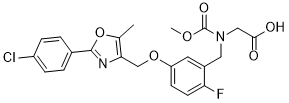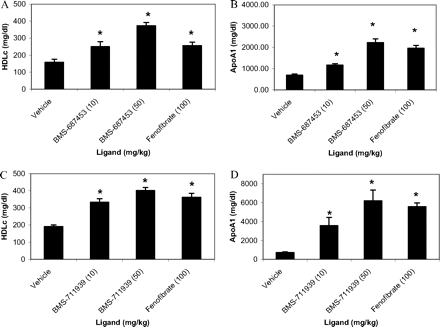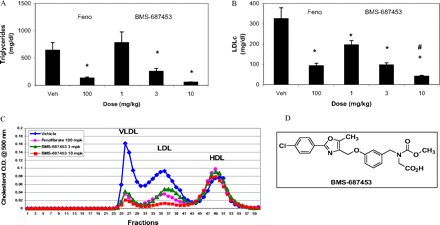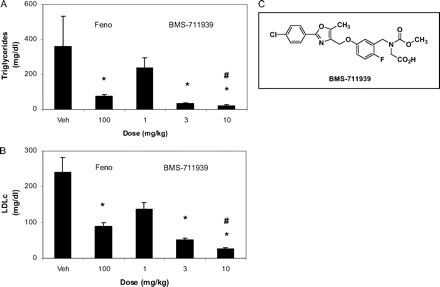This product is for research use only, not for human use. We do not sell to patients.

| Size | Price | Stock |
|---|---|---|
| 5mg | $135 | To Be Confirmed |
| 10mg | $235 | To Be Confirmed |
| 25mg | $409 | To Be Confirmed |
| 50mg | $610 | To Be Confirmed |
| 100mg | $920 | To Be Confirmed |
| 250mg | $1600 | To Be Confirmed |
Cat #: V3800 CAS #: 1000998-62-8 Purity ≥ 98%
Description: BMS-711939, an analog of BMS-687453, is a novel potent and selective peroxisome proliferator activated receptor (PPAR) alpha agonist, with an EC50 and IC50 of 4 nM for human PPARα and >1000-fold selectivity vs human PPARγ (EC50 of 4.5 μM) and PPARδ (EC50 > 100 μM) in PPAR-GAL4 transactivation assays. BMS-711939 has an excellent pharmacological and safety profile in preclinical studies and thus was selected as a drug candidate for the treatment of atherosclerosis and dyslipidemia. BMS-711939 (10, 50, 100, p.o.) dose-dependently increases serum ApoA1 protein levels and low-density lipoprotein-cholesterol (LDLc) levels in mice.
Publications Citing InvivoChem Products
Product Promise

- Physicochemical and Storage Information
- Protocol
- Related Biological Data
- Stock Solution Preparation
- Quality Control Documentation
| Molecular Weight (MW) | 462.86 |
|---|---|
| Molecular Formula | C22H20ClFN2O6 |
| CAS No. | 1000998-62-8 |
| Storage | -20℃ for 3 years in powder form |
| -80℃ for 2 years in solvent | |
| Solubility In Vitro | DMSO: ≥ 30 mg/mL |
| Water: <1 mg/mL | |
| Ethanol: <1 mg/mL | |
| Solubility In Vivo | O=C(O)CN(CC1=CC(OCC2=C(C)OC(C3=CC=C(Cl)C=C3)=N2)=CC=C1F)C(OC)=O |
| Synonyms | BMS-711939; BMS 711939; BMS711939 |
| Protocol | In Vitro | In vitro activity: BMS-711939, an analog of BMS-687453, is a novel potent and selective peroxisome proliferator activated receptor (PPAR) alpha agonist, with an EC50 and IC50 of 4 nM for human PPARα and >1000-fold selectivity vs human PPARγ (EC50 of 4.5 μM) and PPARδ (EC50 > 100 μM) in PPAR-GAL4 transactivation assays. BMS-711939 has an excellent pharmacological and safety profile in preclinical studies and thus was selected as a drug candidate for the treatment of atherosclerosis and dyslipidemia. BMS-711939 (10, 50, 100, p.o.) dose-dependently increases serum ApoA1 protein levels and low-density lipoprotein-cholesterol (LDLc) levels in mice. Kinase Assay: BMS-711939, an analog of BMS-687453, is a novel potent and selective peroxisome proliferator activated receptor (PPAR) alpha agonist, with an EC50 and IC50 of 4 nM for human PPARα and >1000-fold selectivity vs human PPARγ (EC50 of 4.5 μM) and PPARδ (EC50 > 100 μM) in PPAR-GAL4 transactivation assays. BMS-687453 is a potent and selective PPARα agonist, with an EC50 and IC50 of 10 nM and 260 nM for human PPARα and 4100 nM and >15000 nM for PPARγ in PPAR-GAL4 transactivation assays. A homogeneous, fluorescent polarization PPARα and PPARγ binding assay is used as the primary screen for determining the PPARα and PPARγ binding affinity of compounds. The human functional activity of PPARα and PPARγ agonists is determined by using the GAL4-LBD assays. The in vitro hamster, rat, and mouse PPARα functional activities are tested in the chimeric GAL4/PPARα assay format. The data are reported as an EC50value calculated using XLfit 4 parameter fit and floating all parameters. Full length human PPARα and PPARγ co-transfection assays in HepG2 cells are employed for further testing the leading compounds (BMS-687453) Cell Assay: BMS-687453 exhibits high PPARα potency (EC50 = 47 nM) with ∼50-fold selectivity vs PPARγ (EC50 = 2400 nM) in HepG2 cells. However, BMS-687453 shows less potent activities in rodent PPARα functional assays, with a moderate EC50 of 426 nM for mouse and 488 nM for hamster but remains a full PPARα agonist in both species. |
|---|---|---|
| In Vivo | BMS-711939 has an excellent pharmacological and safety profile in preclinical studies and thus was selected as a drug candidate for the treatment of atherosclerosis and dyslipidemia. BMS-711939 (10, 50, 100, p.o.) dose-dependently increases serum ApoA1 protein levels and low-density lipoprotein-cholesterol (LDLc) levels in mice. BMS-687453 exhibits low plasma clearance in the mouse, rat, and monkey and moderate plasma clearance in the dog, and the volume of distribution ranged from 0.7 L/kg (rat) to 3.5 L/kg (cynomolgusmonkey),which is comparable to the total body water in the rat and greater than total body water in the mouse, dog, and monkey. | |
| Animal model | Male 6−8 week old human apoA1 transgenic mice |
| Solvent volume to be added | Mass (the weight of a compound) | |||
|---|---|---|---|---|
| Mother liquor concentration | 1mg | 5mg | 10mg | 20mg |
| 1mM | 2.1605 mL | 10.8024 mL | 21.6048 mL | 43.2096 mL |
| 5mM | 0.4321 mL | 2.1605 mL | 4.3210 mL | 8.6419 mL |
| 10mM | 0.2160 mL | 1.0802 mL | 2.1605 mL | 4.3210 mL |
| 20mM | 0.1080 mL | 0.5401 mL | 1.0802 mL | 2.1605 mL |
This equation is commonly abbreviated as: C1 V1 = C2 V2
- (1) Please be sure that the solution is clear before the addition of next solvent. Dissolution methods like vortex, ultrasound or warming and heat may be used to aid dissolving.
- (2) Be sure to add the solvent(s) in order.







































